 W
WAfter Dinner at Ornans is a 195 by 257 cm painting by Gustave Courbet, painted in winter 1848–1849 in Ornans. It is now in the palais des Beaux-Arts de Lille.
 W
WThe Bacchante is a painting by Gustave Courbet, produced between 1844 and 1847. The painting's title relates the work to images of Bacchantes from Greco-Roman mythology and to Renaissance paintings and sculptures on that subject.
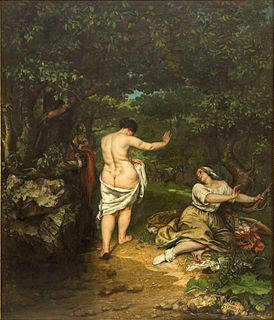 W
WThe Bathers is a painting by Gustave Courbet, first exhibited at the Paris Salon of 1853, where it caused a major scandal. It was unanimously attacked by art critics for the huge nude woman at its centre and the sketchy landscape background, both against official artistic canons. It was bought for 3000 francs by Courbet's future friend Alfred Bruyas, an art collector - this acquisition allowed the artist to become financially and artistically independent. It is signed and dated in the bottom right hand corner on a small rock. It has been in the musée Fabre in Montpellier since 1868.
 W
WA Burial At Ornans is a painting of 1849–50 by Gustave Courbet, and one of the major turning points of 19th-century French art. The painting records the funeral in September 1848 of his great-uncle in the painter's birthplace, the small town of Ornans. It treats an ordinary provincial funeral with unflattering realism, and on the giant scale traditionally reserved for the heroic or religious scenes of history painting. Its exhibition at the 1850–51 Paris Salon created an "explosive reaction" and brought Courbet instant fame. It is currently displayed at the Musée d'Orsay in Paris, France.
 W
WThe Calm Sea is an 1869 painting by Gustave Courbet. Done in oil on canvas, the seascape depicts a beach on the Normandy coast stretched out before the English Channel. The painting is in the collection of the Metropolitan Museum of Art.
 W
WLe Désespéré is an 1843-1845 oil on canvas self-portrait by Gustave Courbet, produced early during his stay in Paris. It is now in the private collection of the Conseil Investissement Art BNP Paribas but was displayed in the Musée d'Orsay's 2007 Courbet exhibition
 W
WFemme nue couchée is an 1862 painting by French Realist painter Gustave Courbet (1819–1877). It depicts a young dark-haired woman reclining on a couch, wearing only a pair of shoes and stockings. Behind her, partly drawn red curtains reveal an overcast sky seen through a closed window. The work is likely influenced by Goya's La maja desnuda.
 W
WThe Fishing Boat is an 1865 painting by French painter Gustave Courbet. Done in oil on canvas, the painting depicts a beached fishing boat on the French coastline near Trouville. It is currently in the collection of the Metropolitan Museum of Art.
 W
WThe Happy Lovers is a title given to a c. 1844 painting by Gustave Courbet, now in the musée des Beaux-Arts de Lyon. One of its earlier titles when exhibited in 1855 at the Pavillon Courbet in Paris was The Waltz. It was sold in the Courbet sale of 1881 and bought by M. Hard and resold to M. Brame, before entering the collection of the musée des Beaux-Arts de Lyon in 1892. The engraver Félix Bracquemond, a friend of the painter, reproduced the work as an etching.
 W
WThe Hunt Breakfast is a large oil on canvas painting completed in 1858 by the French Realism painter Gustave Courbet which is now in the collection of the Wallraf–Richartz Museum in Cologne, Germany. It was painted in Germany during a long stay by the artist in Frankfurt and has probably never left the country.
 W
WJo, the Beautiful Irishwoman is the title of a series of four oil on canvas bust-length portraits by Gustave Courbet. They all show the same redheaded Irish model Joanna Hiffernan looking in a mirror - she also modelled for Whistler. The works have minor differences in details and dimensions but their exact chronology is unknown. They are now in the Nationalmuseum, the Metropolitan Museum of Art, the Nelson-Atkins Museum of Art and a private collection.
 W
WThe Kill - Deer Hunting in the Grand Jura Forests was an 1857 painting by Gustave Courbet. It was his first work on a hunting theme and is now in the Museum of Fine Arts, Boston.
 W
WKilling a Deer or A Deer Hunt – The Kill, is a very large picture, representing a hunting scene, painted in 1867 by Gustave Courbet. The picture is currently on display in the Musée d'Orsay of Paris.
 W
WThe Oak at Flagey or The Vercingetorix Oak is an 1864 landscape painting by Gustave Courbet, measuring 89 by 110 cm. It shows an oak near the Courbet family farm in the village of Flagey, Doubs, a few kilometres from Ornans in Franche-Comté, named in relation to Vercingetorix. The oak was later struck by lightning and no longer survives.
 W
WL'Origine du monde is a picture painted in oil on canvas by the French artist Gustave Courbet in 1866. It is a close-up view of the genitals and abdomen of a naked woman, lying on a bed with legs spread. The framing of the nude body, with head, arms and lower legs outside of view, emphasizes the eroticism of the work.
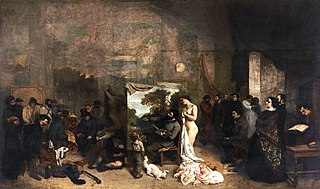 W
WThe Painter's Studio: A real allegory summing up seven years of my artistic and moral life is an 1855 oil on canvas painting by Gustave Courbet. It is located in the Musée d'Orsay in Paris, France.
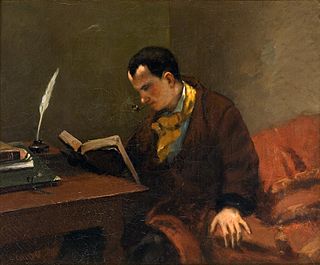 W
WPortrait of Charles Baudelaire is a portrait of the poet Charles Baudelaire by Gustave Courbet. The artist himself dated it to 1840, but it seems to have mostly been painted around 1847, a year in which the poet and the painter met frequently. It was shown in the Courbet Pavilion at the 1855 Exposition Universelle and was bought four years later by the publisher Auguste Poulet-Malassis, who then nominally sold it to Charles Asselineau on 15 June 1862 to prevent it being seized. Alfred Bruyas acquired it for 3000 francs and in 1876 gave it to the Musée Fabre in Montpellier, where it still hangs.
 W
WPortrait of Countess Karoly is an 1865 painting by French realist painter Gustave Courbet.
 W
WPortrait of Paul Chenavard is an 1869 oil on canvas portrait by Gustave Courbet, showing his friend and fellow artist Paul Chenavard aged 62. It was probably produced in Munich during Chenavard's exhibition of The Divine Tragedy, which he had produced for the Panthéon but which had hit difficulties. The portrait is now in the musée des Beaux-Arts de Lyon.
 W
WProudhon and His Children is an 1865 group portrait by Gustave Courbet, now held in the Petit Palais in Paris. The main figure is a posthumously-produced image of Pierre-Joseph Proudhon.
 W
WThe Meeting or "Bonjour, Monsieur Courbet" is an 1854 painting by Gustave Courbet.
 W
WLe ruisseau noir is an oil-on-canvas landscape painted by French artist, Gustave Courbet, in 1865. It is currently held and exhibited at the Musée d'Orsay in Paris.
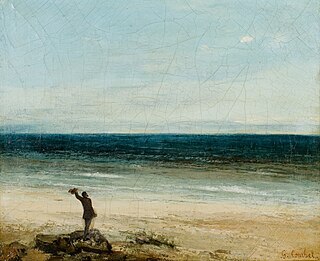 W
WThe Seaside at Palavas is an 1854 painting of the beach at Palavas-les-Flots by Gustave Courbet. It was commissioned by Alfred Bruyas during Courbet's first stay at Montpellier. Courbet originated in Franche-Comté and so the landscapes of Languedoc and the Mediterranean were a revelation. The work was also partly inspired by The Monk by the Sea by Caspar David Friedrich. It is now in the Musée Fabre in Montpellier.
 W
WSelf-Portrait with a Black Dog, Portrait of the Artist or Courbet with a Black Dog is an 1842 painting by Gustave Courbet, retouched by the artist in 1844. It is now in the Petit Palais in Paris.
 W
WLe Sommeil is an erotic oil painting on canvas by French artist Gustave Courbet created in 1866. The painting, which depicts a lesbian couple, is also known as the Two Friends and Indolence and Lust.
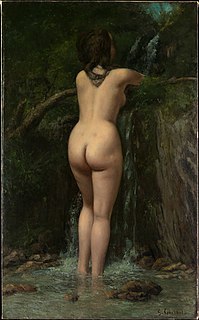 W
WThe Source is a mid 19th-century painting by French artist Gustav Courbet. Done in oil on canvas, the painting depicts a nude women in a stream. Courbet's work is in the collection of the Metropolitan Museum of Art.
 W
WStill-Life with Fruits is a series of still life paintings produced between 1871 and 1872 by Gustave Courbet, marking his return to painting after the silence forced on him by the Franco-Prussian War, the Paris Commune, imprisonment and illness.
 W
WThe Stone Breakers was an 1849 painting by the French painter Gustave Courbet. It was a work of social realism, depicting two peasants, a young man and an old man, breaking rocks.
 W
WThe Source of the Loue is the name of several mid-19th century paintings by French artist Gustav Courbet. Done in oil on canvas, the paintings depict the Loue river in eastern France.
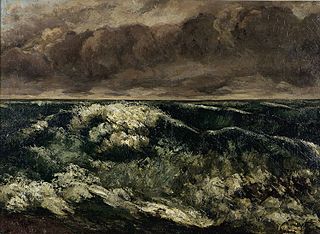 W
WThe Wave or The Waves is the title given to several seascapes painted between 1869 and 1870 by the French painter Gustave Courbet.
 W
WThe Wheat Sifters is an 1854 painting by Gustave Courbet.
 W
WThe Woman in the Waves is an 1868 painting by Gustave Courbet, now in the Metropolitan Museum of Art in New York..
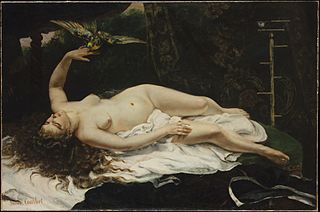 W
WLa Femme au perroquet is an oil painting on canvas by French artist Gustave Courbet. It was the first nude by the artist to be accepted by the Paris Salon in 1866 after a previous entry in 1864 was rejected as indecent. It is in the collection of the Metropolitan Museum of Art in New York city.
 W
WThe Wounded Man is an 1844–1854 self-portrait by Gustave Courbet. Courbet is painted himself in a romantic theme as a suffering heroic man. Originally, there was a woman leaning on the artist's shoulder. She has been replaced by a sword at the end of a love affair, in 1854. He also added a red bloodstain on his shirt. That creates a contrast, because the calm face expression isn't reflecting his bleeding.
 W
WThe Wrestlers is a large 1853 painting by Gustave Courbet, now in the Museum of Fine Arts in Budapest. It shows two men engaged in 'French wrestling', inspired by Greco-Roman wrestling. Documents reveal that it shows a match in the former hippodrome on the Champs-Élysées in Paris. His choice of such a huge canvas inspired Alexandre Falguière's 1875 The Wrestlers.
 W
WYoung Ladies Beside the Seine (Summer) is an oil on canvas painting by Gustave Courbet. He painted it between late 1856 and early 1857 and presented it to the Paris Salon jury, which accepted it and exhibited it on 15 June 1857 with two portraits and three landscapes by the same artist.
 W
WYoung Ladies of the Village or The Village Maids is an 1852 oil on canvas painting by Gustave Courbet, now in the Metropolitan Museum of Art. It is signed bottom left "G. Courbet".